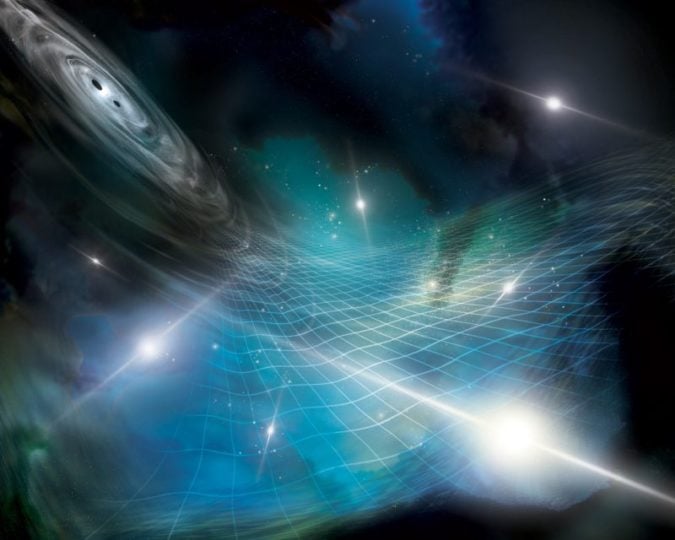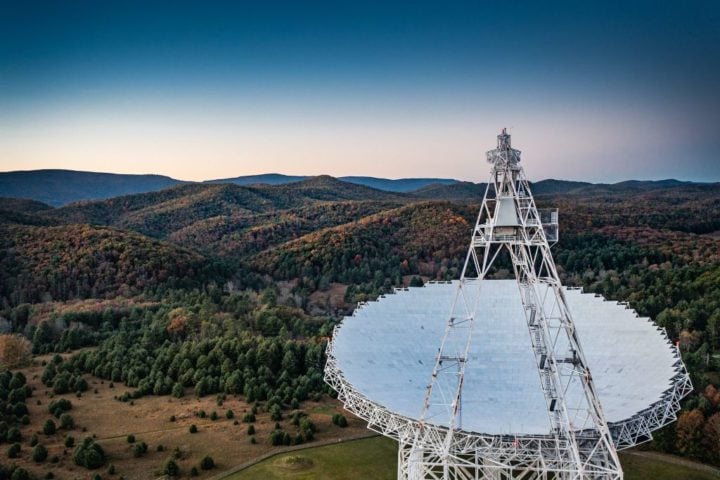Scientists are reporting the first evidence that our Earth and the universe around us are awash in a background of spacetime undulations called gravitational waves.
The waves oscillate very slowly over years and even decades and are thought to originate primarily from pairs of supermassive black holes leisurely spiraling together before they merge.

Artist’s concept of a collection of pulsars that detect gravitational waves from pairs of orbiting supermassive black holes. Image credit: Aurore Simonnet for the NANOGrav Collaboration
The findings, reported in a series of papers in The Astrophysical Journal Letters, come from 15 years’ worth of observations made by the North American Nanohertz Observatory for Gravitational Waves (NANOGrav), a National Science Foundation-funded (NSF) Physics Frontier Center of more than 190 scientists from the United States and Canada.
NANOGrav used data from radio telescopes—the Arecibo Observatory in Puerto Rico, the Green Bank Telescope in West Virginia, and the Very Large Array in New Mexico—to monitor 68 dead stars, called pulsars, in the sky. The pulsars acted like a network of buoys bobbing on a slow-rolling sea of gravitational waves.

Katerina Chatziioannou. Image credit: Caltech
“The effect of the gravitational waves on the pulsars is extremely weak and hard to detect, but we built confidence in the findings over time as we collected more data,” says Katerina Chatziioannou, a NANOGrav team member and an assistant professor of physics at Caltech.
“In the future, we will continue to make more observations and compare our results with those from international partners, allowing us to learn more from the data.”
NSF will host a live presentation about the results at 10 a.m. Pacific/1 p.m. Eastern, on June 29.

Joseph Lazio. Image credit: Caltech
“We have a new way of probing what happens as monstrous black holes at the cores of galaxies begin a slow but inexorable death spiral,” says Joseph Lazio, a NANOGrav team member, a principal scientist at the Jet Propulsion Laboratory (JPL), and a visiting associate in astronomy at Caltech, which manages JPL for NASA.
“We think that this process is standard for many galaxies, and we’ve seen many examples at various steps, but we’re finally starting to glimpse one of the key final steps.”
Gravitational waves were first proposed by Albert Einstein in 1916 but were not directly detected until about 100 years later when the NSF–funded LIGO picked up the waves from a pair of distant colliding black holes.

Patrick Meyers. Image credit: Caltech
LIGO detects gravitational waves that are much higher in frequency than those registered by NANOGrav (NANOGrav’s name comes from the fact that it detects lower-frequency gravitational waves in the nanohertz range—i.e., one cycle every few years).
Higher-frequency gravitational waves come from smaller pairs of black holes zipping around each other rapidly in the final seconds before they collide, while the lower-frequency waves are thought to be generated by huge black holes at the hearts of galaxies, up to billions of times the mass of our sun, that lumber around each slowly and have millions of years to go before they merge.
In the new studies, NANOGrav is thought to have picked up a collective hum of gravitational waves from many pairs of merging supermassive black holes throughout the universe.

Michele Vallisneri. Image credit: Caltech
“People compare this signal to more of a background murmur as opposed to the shouts that LIGO picks up,” explains Chatziioannou, who is also a member of the LIGO team and a William H. Hurt Scholar.
“It’s as if you are at a cocktail party and you can’t pick out any one individual voice. We just hear the background noise,” says Patrick Meyers, a NANOGrav team member and postdoctoral scholar research associate at Caltech who helped lead statistical tests of the results.
NANOGrav’s network of pulsars is also known as a pulsar-timing array. The pulsars, which formed from the explosions of massive stars, send out beacons of light that rapidly spin around at very precise intervals.
“These are like lighthouse beacons that sweep by at a regular rate. You can predict the timing to a level of tens of nanoseconds. They have the same level of precision of atomic clocks in some cases,” says Meyers.
When gravitational waves travel across the cosmos, they stretch and squeeze the fabric of spacetime very slightly.

The Green Bank Telescope in West Virginia was part of the group of telescopes to observe pulsars, an ultra-dense remnant of a massive star’s core following its demise in a supernova explosion, to find evidence for low frequency gravitational waves. Image credit: Jay Young for Green Bank Observatory
This stretching and squeezing can cause the distance between Earth and a given pulsar to minutely change, which results in delays or advances to the timing of the pulsars’ flashes of light. To search for the background hum of gravitational waves, the science team developed software programs to compare the timing of pairs of pulsars in their network.
Gravitational waves will shift this timing to different degrees depending on how close the pulsars are on the sky, a pattern first theoretically calculated by Ron Hellings and George Downs at JPL in the early 1980s.
“Imagine lots of ripples on an ocean from pairs of supermassive black holes scattered throughout,” says Lazio. “Now, we’re sitting here on Earth, which acts like a buoy along with the pulsars, and we try to measure how the ripples are changing and causing the other buoys to move toward and away from us.”
“To tease out the gravitational-wave background, we had to nail down a multitude of confusing effects, such as the motion of the pulsars, the perturbations due to the free electrons in our galaxy, the instabilities of the reference clocks at the radio observatories, and even the precise location of the center of the solar system, which we determined with help from NASA’s Juno and Cassini missions,” says Michele Vallisneri, a NANOgrav team member, a senior research scientist at JPL, and a visiting associate in theoretical astrophysics at Caltech.
Future NANOGrav results will include Canada’s CHIME telescope, which joined the project in 2019. Caltech’s Deep Synoptic Array-2000, or DSA-2000, an array of 2,000 radio antennae planned to be built in the Nevada desert and begin operations in 2027, will also join the search.
The scientists hope to answer mysteries about the nature of merging supermassive black holes, such as how common they are, what brings them together, and what other factors contribute to their coalescence.
“People have tried to find merging supermassive black holes with telescopes for years,” says Chatziioannou. “They are getting closer and finding more candidates, but because the black holes are so close together, they are hard to distinguish. Having gravitational waves as a new tool will help better understand these enigmatic beasts.”
“This was such a beautiful, unlikely experiment: assembling a galactic-size gravitational-wave detector animated by the pulse of dead stars across our galaxy and bringing together a multidisciplinary team of radio astronomers, neutron-star and black-hole experts, and gravitational-wave scientists,” says Vallisneri.
Written by Whitney Clavin
Source: Caltech

